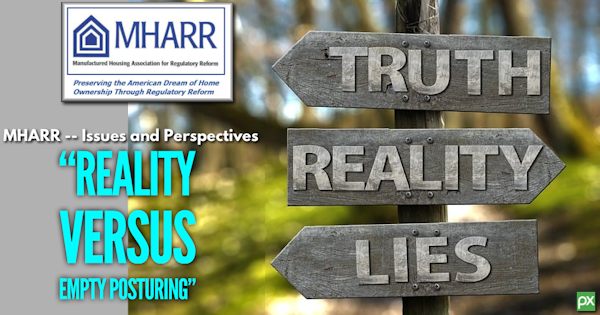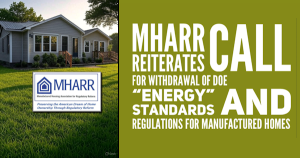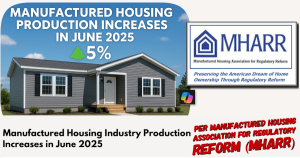MHARR — Issues and Perspectives “Reality Versus Empty Posturing”

MHARR – ISSUES AND PERSPECTIVES
By Mark Weiss
MAY 2024
“REALITY VERSUS EMPTY POSTURING”
Henry David Thoreau, in the classic, “Walden,” lamented that “shams and delusions are esteemed for [the] soundest truths, while reality is fabulous.” He observed that if “men would steadily observe realities only” and “not allow themselves to be deluded,” life would be far better. Although those words were penned nearly two centuries ago, they remain as poignant, relevant and accurate today (if not more so) as when they were first written. And one area where they should be applied – carefully and thoughtfully – in the context of federally-regulated manufactured housing, is with respect to the way that the industry itself refers to and promotes mainstream HUD Code manufactured housing, and presents manufactured housing, both as a product and as an industry, to the homebuying public and government decision-makers including, most especially, those at the federal level, where manufactured housing is comprehensively regulated and controlled.
In this regard, it is beyond any reasonable debate that “affordability” has always been the fundamental defining characteristic – and market-based driver – of the availability, acceptance and utilization of mainstream HUD Code manufactured homes. Indeed, “affordability,” in both absolute and relative terms, is so central to the consumer market for federally-regulated manufactured homes, that the term “affordability” was inserted into federal manufactured housing law by Congress when it adopted the Manufactured Housing Improvement Act of 2000 (2000 Reform Law).
In that watershed law, which marked the emergence of today’s modern, high-quality, energy-efficient, mainstream manufactured housing, the term “affordable” or “affordability” is expressly used at least four times, while there are at least two parallel (and effectively synonymous) references to “cost-effectiveness.” Indeed, the very first legislative purpose of the 2000 Reform Law, as enumerated by Congress, is to “protect the quality, durability, safety and affordability of manufactured homes.” (Emphasis added). The point made abundantly clear by Congress, accordingly, as a matter of law, is that cost-effective “affordability” lies at the heart of the construction, use and regulation of manufactured housing, and that elemental affordability is not to be undermined or subverted by other factors or considerations outside of imperative life-safety. As such, affordability is the fundamental lynchpin of the three main pillars of federal manufactured housing law, as federal preemption, uniform federal standards and uniform federal regulation work in unison to yield inherently affordable manufactured housing and distinguish manufactured housing from all other types of factory-built housing.
Nor has the concept and primary importance of affordability in relation to housing, homeownership and the manufactured housing market, somehow gone out of style over the 24 years that have elapsed since the enactment of the 2000 Reform Law. If anything, the need for affordable housing and homeownership – at a time when housing affordability in the United States is at an all-time low – has never been greater. As a result, federal government policies to promote the availability of “affordable” housing have never had a higher priority.
How do we know this? For one thing, the Biden Administration is earmarking billions of dollars in federal spending on supposedly “affordable” housing. It also stresses (or at least pays lip service) to the need for “affordable” homeownership in its policy pronouncements. In an April 2024 document, “Decarbonizing the U.S. Economy by 2050 – A Blueprint for the Buildings Sector,” for example, the Administration states: “Any pathway to decarbonization of the buildings sector must be centered in the cross-cutting goals of equity [and] affordability….” (Emphasis added). Nor is housing “affordability” some abstract, amorphous or metaphysical construct that has no specific or well-understood meaning. As HUD’s Office of Policy Development and Research (PD&R) noted in an August 2017 article, “Defining Housing Affordability,” “Housing programs in the United States have long measured housing affordability in terms of percentage of income. *** Over time, [a] 30 percent threshold … became the standard for owner-occupied housing, and it remains the indicator of affordability for housing in the United States.” (Emphasis added). By contrast, “households [that] spend more than 30 percent of income on housing costs [are] housing cost burdened.”
Measured against this standard, mainstream HUD Code manufactured housing has always been inherently affordable. In 2022, the last full year for which census data is available, the average sales price of all new manufactured homes was $127,300.00. This compares to a $430,808.00 “average” for a site-built home, excluding the cost of land. That same year, again according to U.S. Census Bureau data, real median household income in the United States was $74,580.00. At the census average price, a 20-year loan on a manufactured home with a 5% downpayment, would cost the borrower less than $1,000.00 per month, or slightly more than 16% of average gross income. By contrast, a mortgage on the “average” site-built home, exclusive of land, would cost approximately $2,300.00 per month over a 30-year loan period at 7.0% interest, requiring 37% or more of the buyer’s gross income, a proportion that would be significantly larger based on net income following the deduction of income and other applicable taxes. And, when the site-built information is brought forward to 2024, the current median monthly home mortgage payment in the United States is $2,775.00 a month, “the most expensive ever” according to media reports.
Against this backdrop of all-too-real disappearing affordability within the broader housing market, it is mystifying and frankly astounding that some within the HUD Code industry would so readily surrender, dispense with and, effectively walk away from the language, concept and reality of “affordability” in relation to mainstream HUD Code manufactured homes, and instead embrace the meaningless linguistic blather of “attainable” housing (much like substituting the recently-invented term of “off-site”-built housing for the traditionally-known term “factory-built” housing). With this term appearing more frequently in both industry trade publications and broader media from manufactured housing producers – among others — the industry would do well to consider the dangers and pitfalls of abandoning the well-known, well-defined and well-appreciated concept, terminology and reality of “affordability.”
So where has this abandonment of “affordability” manifested itself within the industry and – more importantly – why has it been advanced and promoted by some? The answers are fairly easy to find with a bit of research. The “where” question is perhaps easiest. News releases published in recent years by Berkshire Hathaway, Inc. subsidiary Clayton Homes, Inc. (Clayton) tout “net zero energy” manufactured homes that – wait for it – are “attainable.” In an April 29, 2022 news release announcing a “net zero energy” home displayed at the Berkshire Hathaway shareholder meeting, Clayton noted that it was committed to build “attainable” homes. Subsequently, in a July 10, 2023 news release announcing the debut of manufactured homes “built to the U.S. Department of Energy’s (DOE) “Zero Energy Ready Home” specifications,” Clayton characterized those homes as a response to “rising home energy costs that threaten attainable homeownership.” (Emphasis added). And now – in a step that will come as a surprise to exactly no one – the Manufactured Housing Institute (MHI) has followed the lead of its largest manufacturer member, to embrace the term “attainable” manufactured housing in its messaging.
So, what is an “attainable” manufactured home? What does that term mean? And why the retreat from “affordable” to “attainable?” Again, the answers are fairly straightforward. Depending on who you believe, a Clayton “net zero electricity home,” in 2022, cost just under $230,000” before the cost of land and solar panels (per a Clayton news release), or “just under $250,000 “with solar before land costs” (according to a media report). So, in short, a net-zero manufactured home, in 2022, carried a price tag that was nearly double the 2022 cost of an “average” mainstream manufactured home according to the U.S. Census Bureau. It’s easy to see, then, why these homes are characterized with the meaningless word “attainable.” It is because they are not particularly “affordable” when compared with the average modern, energy-efficient mainstream manufactured home and could easily (with both solar panel and land costs) exceed the “affordability” benchmark of 30% of a borrower’s income for the lower and moderate-income Americans who currently – and historically – have constituted the core of the industry’s consumer base.
And what causes these particular “factory-built” homes to be less than “affordable” for many? Because they seek to attain the climate-activist (and DOE) holy grail of net zero energy consumption. And in doing so – as MHARR has argued from day-one against the extremist DOE manufactured housing energy standards – they will exclude huge numbers of Americans from the manufactured housing market, precisely because they will not be truly “attainable” or affordable for many, if not most, of the industry’s historical market demographic.
According to a Consumer Finance Protection Bureau (CFPB) report issued in May 2021, the median income of a manufactured home purchaser (for both mortgage and chattel financing) was between $52,000 and $53,000 per year. According to online resources, a person with an annual income of $52,000 could “comfortably” afford a home costing $158,624, with a 5% downpayment and a monthly payment of $1,300 per month (an estimated home only payment that does not include variables like site fees, utilities, taxes, insurance, or escrows). As noted above, this would cover the cost of the “average” modern-day, new, energy-efficient mainstream, HUD Code manufactured home. But it does not cover – or even come close to covering – the cost of a $250,000(+) supposedly “attainable” net zero manufactured home, plus the cost of land and other essentials needed for net zero living.
So, not only does “attainable” – as contrasted with “affordable” – mean absolutely nothing in relation to manufactured housing, its use demonstrates, once again, that all of the supposed “life-cycle” energy savings on the face of the planet will not benefit, in any conceivable way, the vast majority of current manufactured homebuyers, who would effectively be excluded from the housing market altogether by the additional cost of the measures needed to meet net zero energy criteria. Put differently, it confirms that there is no “life-cycle” – and, therefore, no life-cycle “savings” — for those who do not have a home to begin with, because they cannot afford the home’s purchase price.
This dichotomy once again proves and underscores the essential thrust of MHARR’s longstanding and aggressive opposition to DOE’s horrific manufactured housing “energy” standards. What it does not answer, is why – other than for purposes of posturing, grandstanding (or possibly glomming “energy” tax credits) – anyone in the manufactured housing industry would seek to economically disenfranchise nearly all of its current consumers and market. Unlike the term “attainable,” “economic suicide” does have a specific meaning. And inviting it is not smart.
Mark Weiss
MHARR is a Washington, D.C.-based national trade association representing the views and interests of independent producers of federally-regulated manufactured housing.
“MHARR-Issues and Perspectives” is available for re-publication in full (i.e., without alteration or substantive modification) without further permission and with proper attribution and/or link back to MHARR.

MHARR – ISSUES AND PERSPECTIVES
By Mark Weiss
MAY 2024
“REALITY VERSUS EMPTY POSTURING”
Henry David Thoreau, in the classic, “Walden,” lamented that “shams and delusions are esteemed for [the] soundest truths, while reality is fabulous.” He observed that if “men would steadily observe realities only” and “not allow themselves to be deluded,” life would be far better. Although those words were penned nearly two centuries ago, they remain as poignant, relevant and accurate today (if not more so) as when they were first written. And one area where they should be applied – carefully and thoughtfully – in the context of federally-regulated manufactured housing, is with respect to the way that the industry itself refers to and promotes mainstream HUD Code manufactured housing, and presents manufactured housing, both as a product and as an industry, to the homebuying public and government decision-makers including, most especially, those at the federal level, where manufactured housing is comprehensively regulated and controlled.
In this regard, it is beyond any reasonable debate that “affordability” has always been the fundamental defining characteristic – and market-based driver – of the availability, acceptance and utilization of mainstream HUD Code manufactured homes. Indeed, “affordability,” in both absolute and relative terms, is so central to the consumer market for federally-regulated manufactured homes, that the term “affordability” was inserted into federal manufactured housing law by Congress when it adopted the Manufactured Housing Improvement Act of 2000 (2000 Reform Law).
In that watershed law, which marked the emergence of today’s modern, high-quality, energy-efficient, mainstream manufactured housing, the term “affordable” or “affordability” is expressly used at least four times, while there are at least two parallel (and effectively synonymous) references to “cost-effectiveness.” Indeed, the very first legislative purpose of the 2000 Reform Law, as enumerated by Congress, is to “protect the quality, durability, safety and affordability of manufactured homes.” (Emphasis added). The point made abundantly clear by Congress, accordingly, as a matter of law, is that cost-effective “affordability” lies at the heart of the construction, use and regulation of manufactured housing, and that elemental affordability is not to be undermined or subverted by other factors or considerations outside of imperative life-safety. As such, affordability is the fundamental lynchpin of the three main pillars of federal manufactured housing law, as federal preemption, uniform federal standards and uniform federal regulation work in unison to yield inherently affordable manufactured housing and distinguish manufactured housing from all other types of factory-built housing.
Nor has the concept and primary importance of affordability in relation to housing, homeownership and the manufactured housing market, somehow gone out of style over the 24 years that have elapsed since the enactment of the 2000 Reform Law. If anything, the need for affordable housing and homeownership – at a time when housing affordability in the United States is at an all-time low – has never been greater. As a result, federal government policies to promote the availability of “affordable” housing have never had a higher priority.
How do we know this? For one thing, the Biden Administration is earmarking billions of dollars in federal spending on supposedly “affordable” housing. It also stresses (or at least pays lip service) to the need for “affordable” homeownership in its policy pronouncements. In an April 2024 document, “Decarbonizing the U.S. Economy by 2050 – A Blueprint for the Buildings Sector,” for example, the Administration states: “Any pathway to decarbonization of the buildings sector must be centered in the cross-cutting goals of equity [and] affordability….” (Emphasis added). Nor is housing “affordability” some abstract, amorphous or metaphysical construct that has no specific or well-understood meaning. As HUD’s Office of Policy Development and Research (PD&R) noted in an August 2017 article, “Defining Housing Affordability,” “Housing programs in the United States have long measured housing affordability in terms of percentage of income. *** Over time, [a] 30 percent threshold … became the standard for owner-occupied housing, and it remains the indicator of affordability for housing in the United States.” (Emphasis added). By contrast, “households [that] spend more than 30 percent of income on housing costs [are] housing cost burdened.”
Measured against this standard, mainstream HUD Code manufactured housing has always been inherently affordable. In 2022, the last full year for which census data is available, the average sales price of all new manufactured homes was $127,300.00. This compares to a $430,808.00 “average” for a site-built home, excluding the cost of land. That same year, again according to U.S. Census Bureau data, real median household income in the United States was $74,580.00. At the census average price, a 20-year loan on a manufactured home with a 5% downpayment, would cost the borrower less than $1,000.00 per month, or slightly more than 16% of average gross income. By contrast, a mortgage on the “average” site-built home, exclusive of land, would cost approximately $2,300.00 per month over a 30-year loan period at 7.0% interest, requiring 37% or more of the buyer’s gross income, a proportion that would be significantly larger based on net income following the deduction of income and other applicable taxes. And, when the site-built information is brought forward to 2024, the current median monthly home mortgage payment in the United States is $2,775.00 a month, “the most expensive ever” according to media reports.
Against this backdrop of all-too-real disappearing affordability within the broader housing market, it is mystifying and frankly astounding that some within the HUD Code industry would so readily surrender, dispense with and, effectively walk away from the language, concept and reality of “affordability” in relation to mainstream HUD Code manufactured homes, and instead embrace the meaningless linguistic blather of “attainable” housing (much like substituting the recently-invented term of “off-site”-built housing for the traditionally-known term “factory-built” housing). With this term appearing more frequently in both industry trade publications and broader media from manufactured housing producers – among others — the industry would do well to consider the dangers and pitfalls of abandoning the well-known, well-defined and well-appreciated concept, terminology and reality of “affordability.”
So where has this abandonment of “affordability” manifested itself within the industry and – more importantly – why has it been advanced and promoted by some? The answers are fairly easy to find with a bit of research. The “where” question is perhaps easiest. News releases published in recent years by Berkshire Hathaway, Inc. subsidiary Clayton Homes, Inc. (Clayton) tout “net zero energy” manufactured homes that – wait for it – are “attainable.” In an April 29, 2022 news release announcing a “net zero energy” home displayed at the Berkshire Hathaway shareholder meeting, Clayton noted that it was committed to build “attainable” homes. Subsequently, in a July 10, 2023 news release announcing the debut of manufactured homes “built to the U.S. Department of Energy’s (DOE) “Zero Energy Ready Home” specifications,” Clayton characterized those homes as a response to “rising home energy costs that threaten attainable homeownership.” (Emphasis added). And now – in a step that will come as a surprise to exactly no one – the Manufactured Housing Institute (MHI) has followed the lead of its largest manufacturer member, to embrace the term “attainable” manufactured housing in its messaging.
So, what is an “attainable” manufactured home? What does that term mean? And why the retreat from “affordable” to “attainable?” Again, the answers are fairly straightforward. Depending on who you believe, a Clayton “net zero electricity home,” in 2022, cost just under $230,000” before the cost of land and solar panels (per a Clayton news release), or “just under $250,000 “with solar before land costs” (according to a media report). So, in short, a net-zero manufactured home, in 2022, carried a price tag that was nearly double the 2022 cost of an “average” mainstream manufactured home according to the U.S. Census Bureau. It’s easy to see, then, why these homes are characterized with the meaningless word “attainable.” It is because they are not particularly “affordable” when compared with the average modern, energy-efficient mainstream manufactured home and could easily (with both solar panel and land costs) exceed the “affordability” benchmark of 30% of a borrower’s income for the lower and moderate-income Americans who currently – and historically – have constituted the core of the industry’s consumer base.
And what causes these particular “factory-built” homes to be less than “affordable” for many? Because they seek to attain the climate-activist (and DOE) holy grail of net zero energy consumption. And in doing so – as MHARR has argued from day-one against the extremist DOE manufactured housing energy standards – they will exclude huge numbers of Americans from the manufactured housing market, precisely because they will not be truly “attainable” or affordable for many, if not most, of the industry’s historical market demographic.
According to a Consumer Finance Protection Bureau (CFPB) report issued in May 2021, the median income of a manufactured home purchaser (for both mortgage and chattel financing) was between $52,000 and $53,000 per year. According to online resources, a person with an annual income of $52,000 could “comfortably” afford a home costing $158,624, with a 5% downpayment and a monthly payment of $1,300 per month (an estimated home only payment that does not include variables like site fees, utilities, taxes, insurance, or escrows). As noted above, this would cover the cost of the “average” modern-day, new, energy-efficient mainstream, HUD Code manufactured home. But it does not cover – or even come close to covering – the cost of a $250,000(+) supposedly “attainable” net zero manufactured home, plus the cost of land and other essentials needed for net zero living.
So, not only does “attainable” – as contrasted with “affordable” – mean absolutely nothing in relation to manufactured housing, its use demonstrates, once again, that all of the supposed “life-cycle” energy savings on the face of the planet will not benefit, in any conceivable way, the vast majority of current manufactured homebuyers, who would effectively be excluded from the housing market altogether by the additional cost of the measures needed to meet net zero energy criteria. Put differently, it confirms that there is no “life-cycle” – and, therefore, no life-cycle “savings” — for those who do not have a home to begin with, because they cannot afford the home’s purchase price.
This dichotomy once again proves and underscores the essential thrust of MHARR’s longstanding and aggressive opposition to DOE’s horrific manufactured housing “energy” standards. What it does not answer, is why – other than for purposes of posturing, grandstanding (or possibly glomming “energy” tax credits) – anyone in the manufactured housing industry would seek to economically disenfranchise nearly all of its current consumers and market. Unlike the term “attainable,” “economic suicide” does have a specific meaning. And inviting it is not smart.
Mark Weiss
MHARR is a Washington, D.C.-based national trade association representing the views and interests of independent producers of federally-regulated manufactured housing.
“MHARR-Issues and Perspectives” is available for re-publication in full (i.e., without alteration or substantive modification) without further permission and with proper attribution and/or link back to MHARR.













